Scandinavian regions in recent years have produced some fine young prospects. The likes of Erling Haaland is taking the world by storm and has quickly become the best U-23 striker on the planet. In Sweden, we can say a certain someone who is catching the eye of a lot of football followers. It’s Hammarby’s very own 17-year old attacking midfielder Williot Swedberg.
After attracting interest from Danish clubs like Midtjylland and Borndby, he signed a new contract with his parent club to extend it to 2024. He is highly rated by his team as well Hammarby fans.
In this scout report, we will be looking into his strengths and weakness on which he would need to show more development. This tactical analysis will also discuss the different abilities he brings to the table. Let’s begin the analysis.
Player Profile
Swedberg is a right-footed player and has played in quite a few different starting positions this season. We can see from the image below that he has played as a wide left midfielder when he has played in a 4-4-2 and as a central midfielder in a 3-men midfield he has been deployed on both the right as well as the left side. Even when he has played as a CM, he would be kept a little more advanced when compared to his partner on the other side, which we will be discussing later in the article.
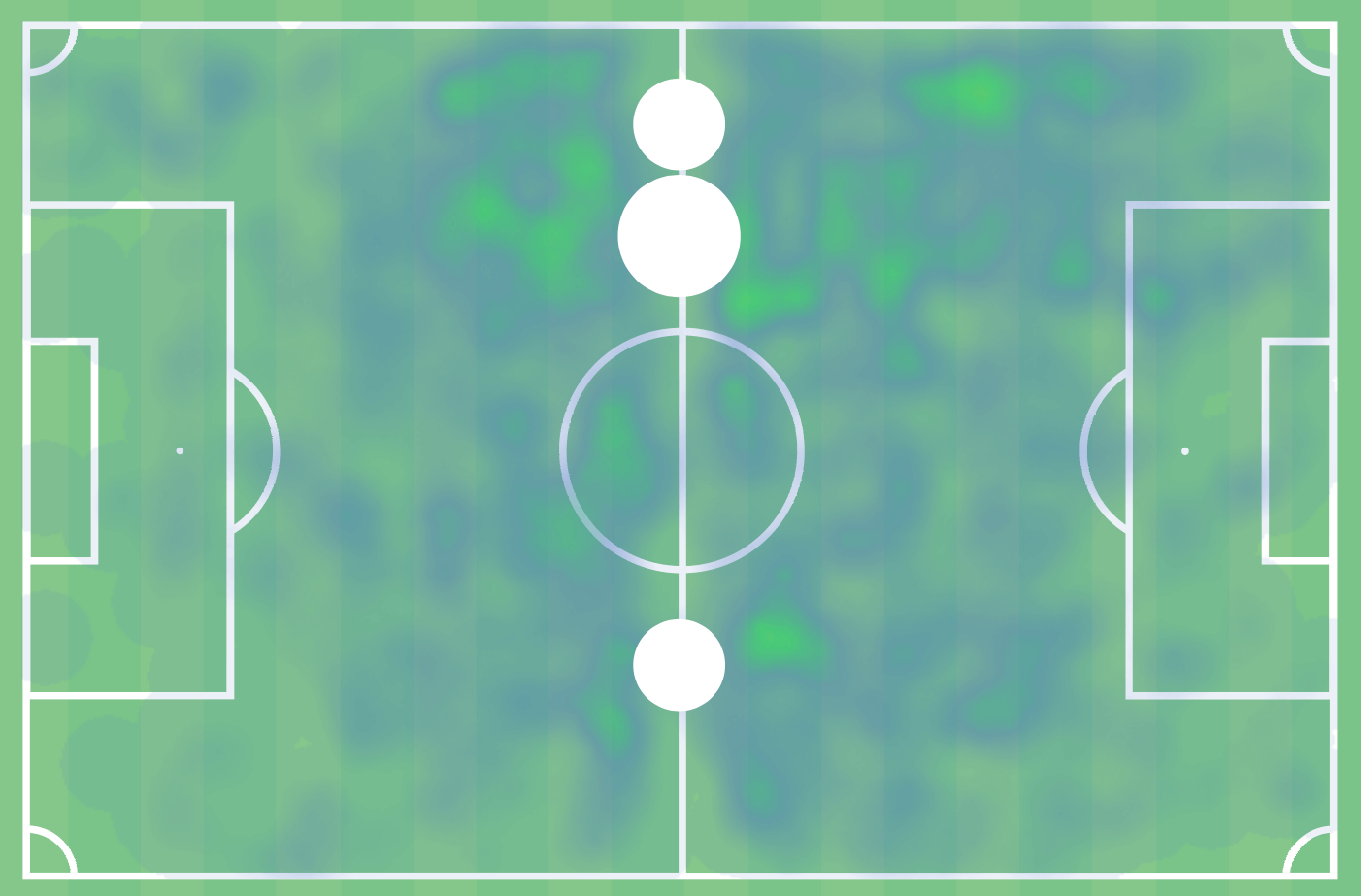
More or less Hammarby and Miloš Milojević have given the teenager more freedom to express himself on the pitch and have not hesitated to deploy him as a CAM in a 4-2-3-1 system or charge him a lot with his tactics. We can see from the map that most of his actions are flowing down the wing especially on the left side where he moves or even indulges in positional rotations with his teammates.
Off-the ball runs and dynamic movements
Before getting deep into his attacking abilities, we can say that Swedberg is more of a space operator where he likes to get into the vacated spaces and make movements off-the-ball. This is a playstyle that is very much associated with the likes of Thomas Muller, throughout his career at Bayern Munich and for the German national team and Donny Van de Beek of Manchester United who also plays similar to the German during his Ajax days. This is a very good quality for a midfielder to have especially in a world where a lot of young talents or prospects develop their career asking for the ball to their feet, the space-operator is a very good counter role for such players and a combination of both of them in the team can be very daunting for the opposition.
We can see an example of Swedberg looking to make a run into the space in the image below where the ball is in the flank and Swedberg has recognized that there is a space in the channel between the full-back and the CB. This means that his teammate who has the ball now has a passing option that he can play to. Also even without that passing scenario, his run is valuable here where he drags the midfielder with him opening a huge space in front of the defence for his team to use.
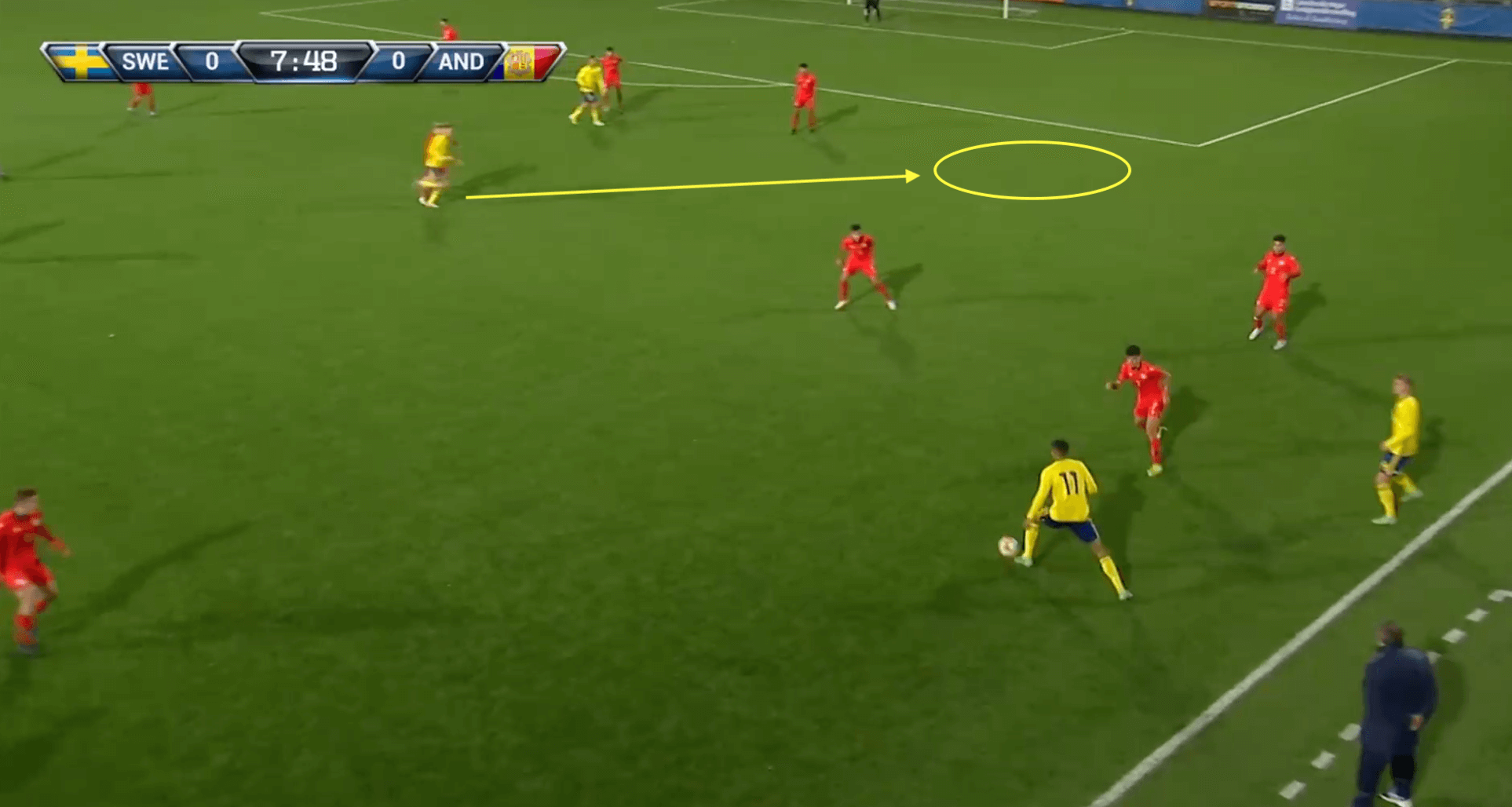
This can be very useful for any team looking to play through a defensively structured and organized team. The runs into the spaces can be more effectively completed if the player moves on the blindside of the opponent player occupying the zone. Swedberg does something like this more often and has the knack of constantly escaping his marker using the blindside. We can see an example of that below where he looks to receive the ball from a throw-in and makes a run into the box on the blindside of the opposition’s midfielder. He adds a lot of value in receiving passes for his team which is also confirmed by the statistics where he has received an average of 25.79 passes per game from his teammates.
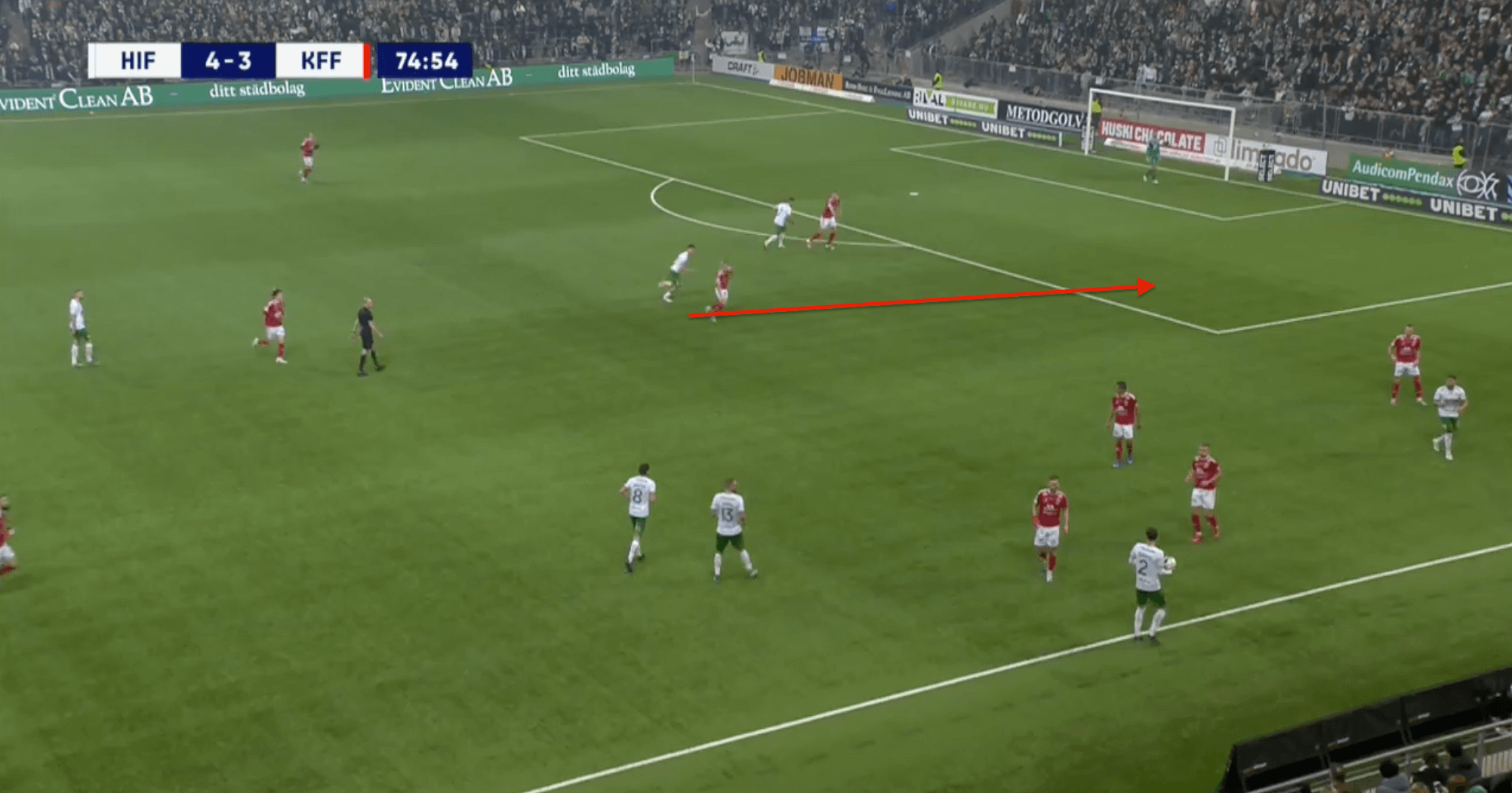
As said before, he is often deployed as the advanced CM by his manager and plays the same role even for his national team at the youth level. This means that he often occupies the last line in most situations and looks pin the defence along with his striker. We can see an example of that in the image below where he positions himself in the last line while also in the gap between the CB and FB.
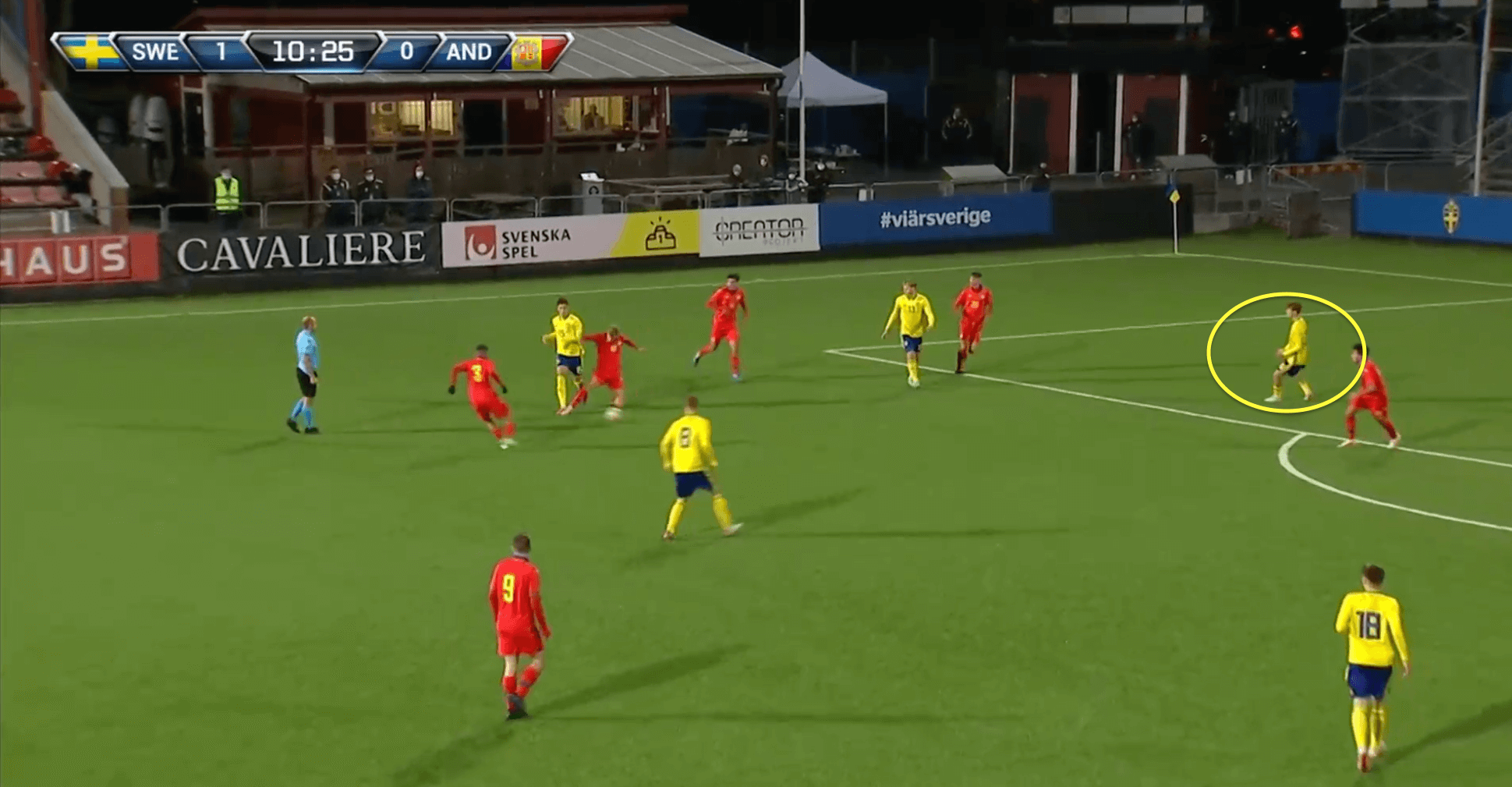
He also recognizes good timing to make movements when his team’s CF drops deep and looks to occupy that space that is being created due to the forward’s movement. This is possible due to the chemistry he looks to build or has built with his CF and also tells more about his style of play. In the example below we can see that he makes run into the space as his CF drops deep.
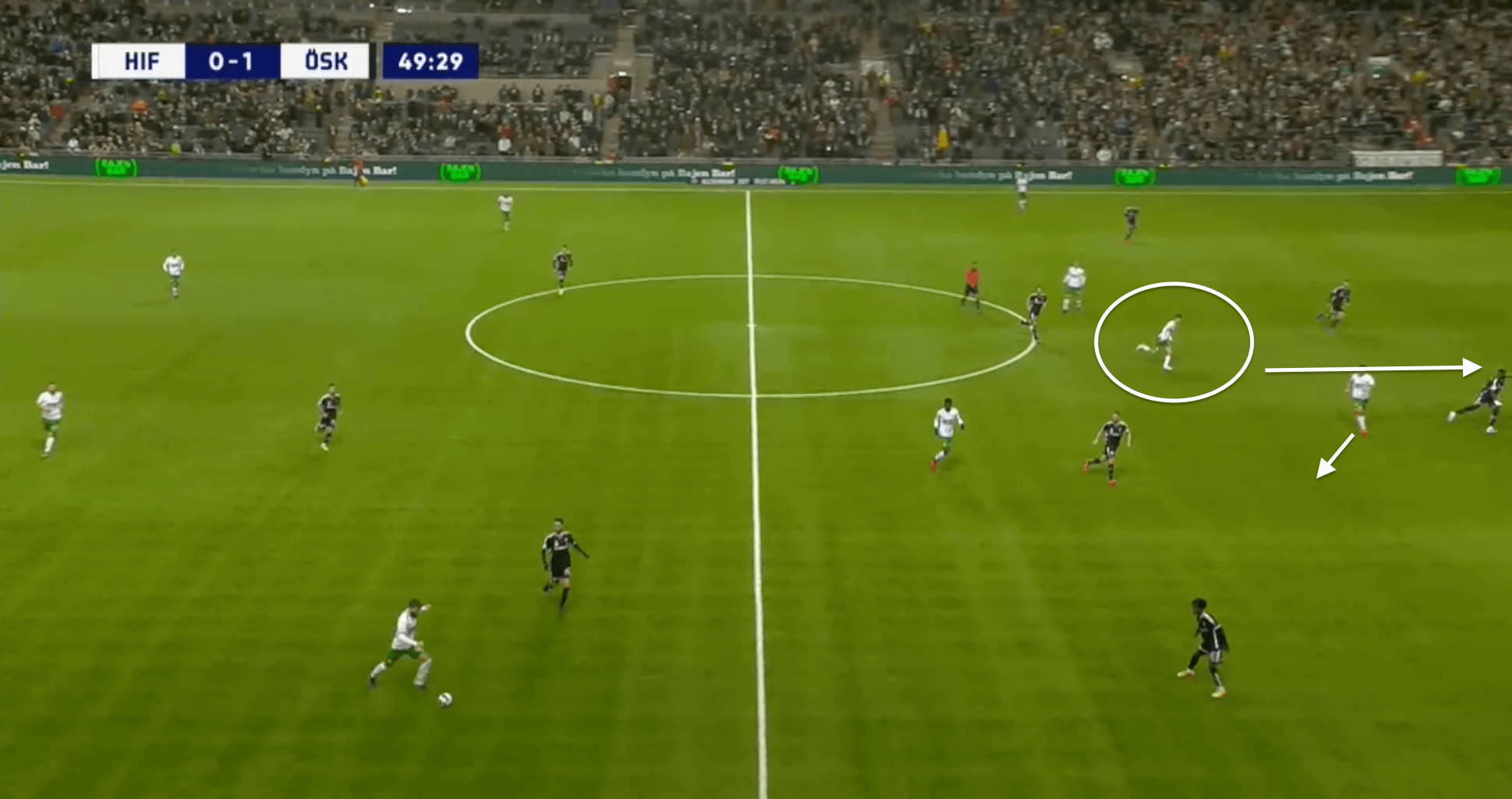
Another example is when he moves into the box along in the same direction as his striker but uses CF’s run which drags both the CBs with him allowing Williot to make a run and take a shot with space in front of him. This sudden run from him also disables any chance that the defenders beside have to mark him.
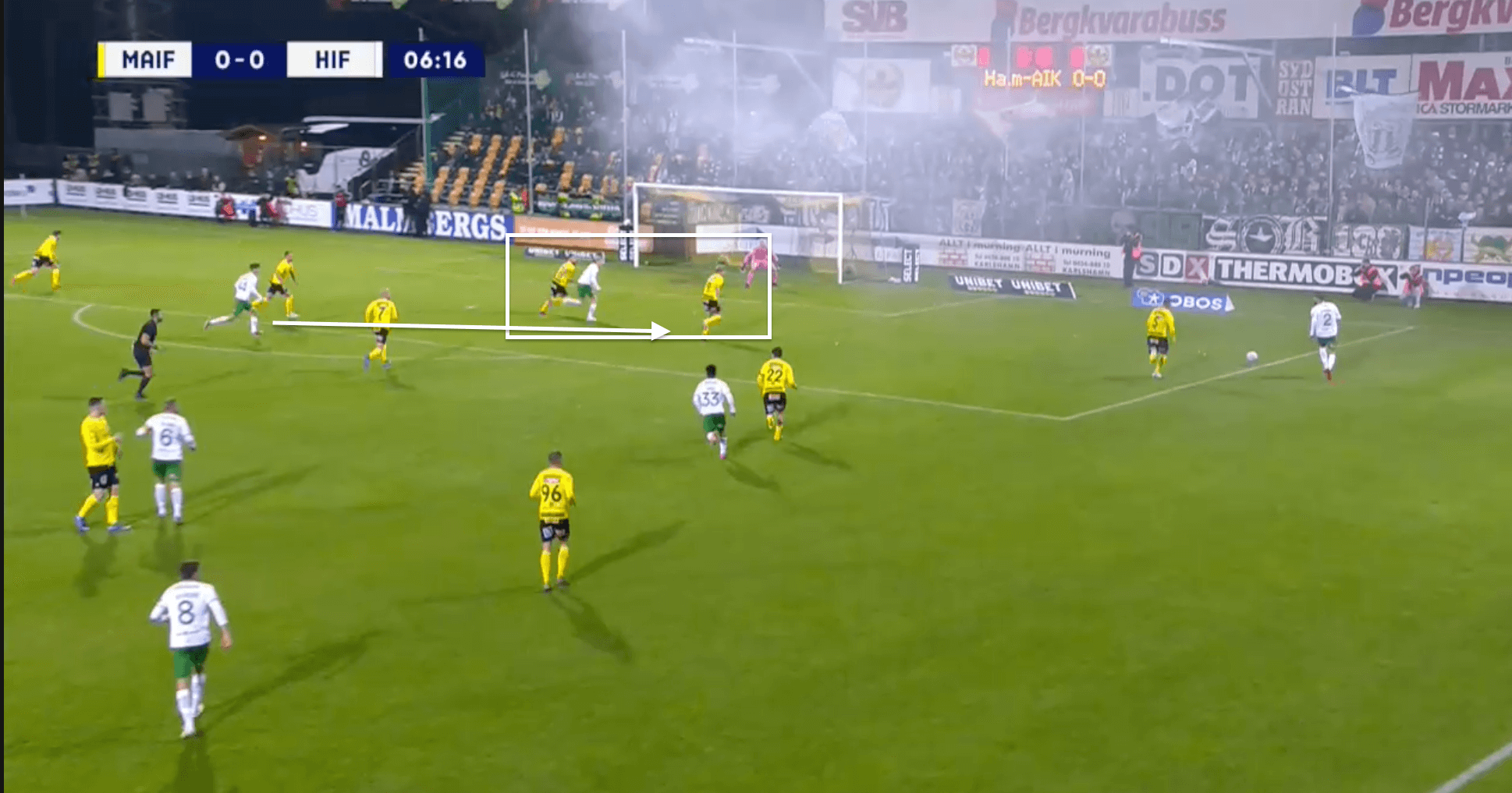
Getting into good scoring positions is very key for an attacker to sustain his goal output for a very long time. Over-performing xG is something that is not sustainable for any non-Messi footballer in the long term. So with regard to this aspect, Swedberg does very well to get into good scoring positions using his movement. We can see the image below which shows the locations where he has taken most of his shots. We see that he hasn’t taken a lot of shots outside the box where most of the attacking midfielders tend to take from. We also see that most of his shots occur from the centre of the penalty box and also he has taken quite a good number of shots inside the 6-yard area where xG are very high. He has averaged 2.2 shots per game and his average xG per shot is 0.15 which is a very good measure for someone who doesn’t take penalties and is something from which he can genuinely convert into goals.
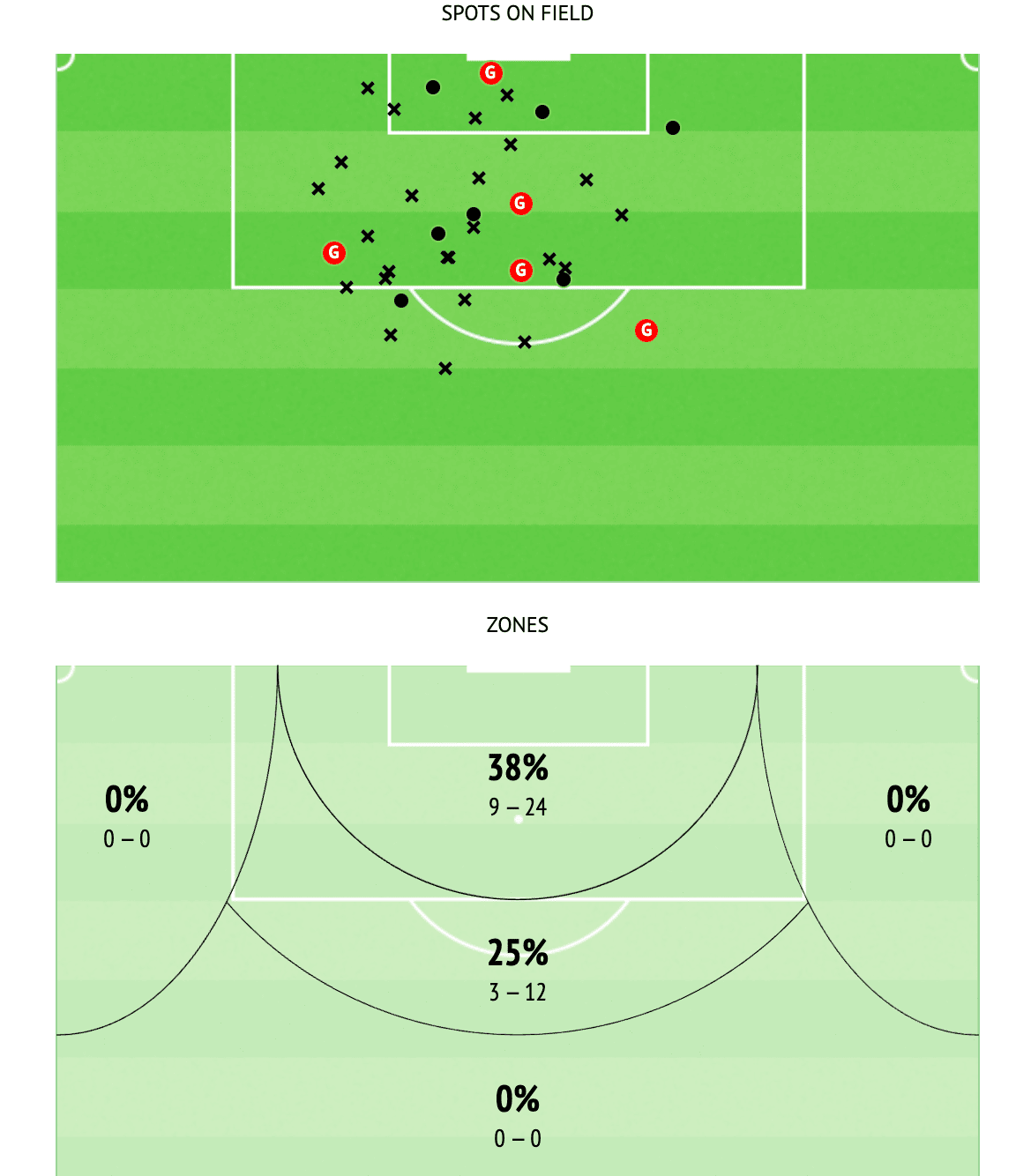
He is also adept in making dynamic movements forward from the deep and also has a good body orientation when making such runs too. We can see that in the image when he makes a runs from the deep and receives in a very good angle smoothly and take it forward.
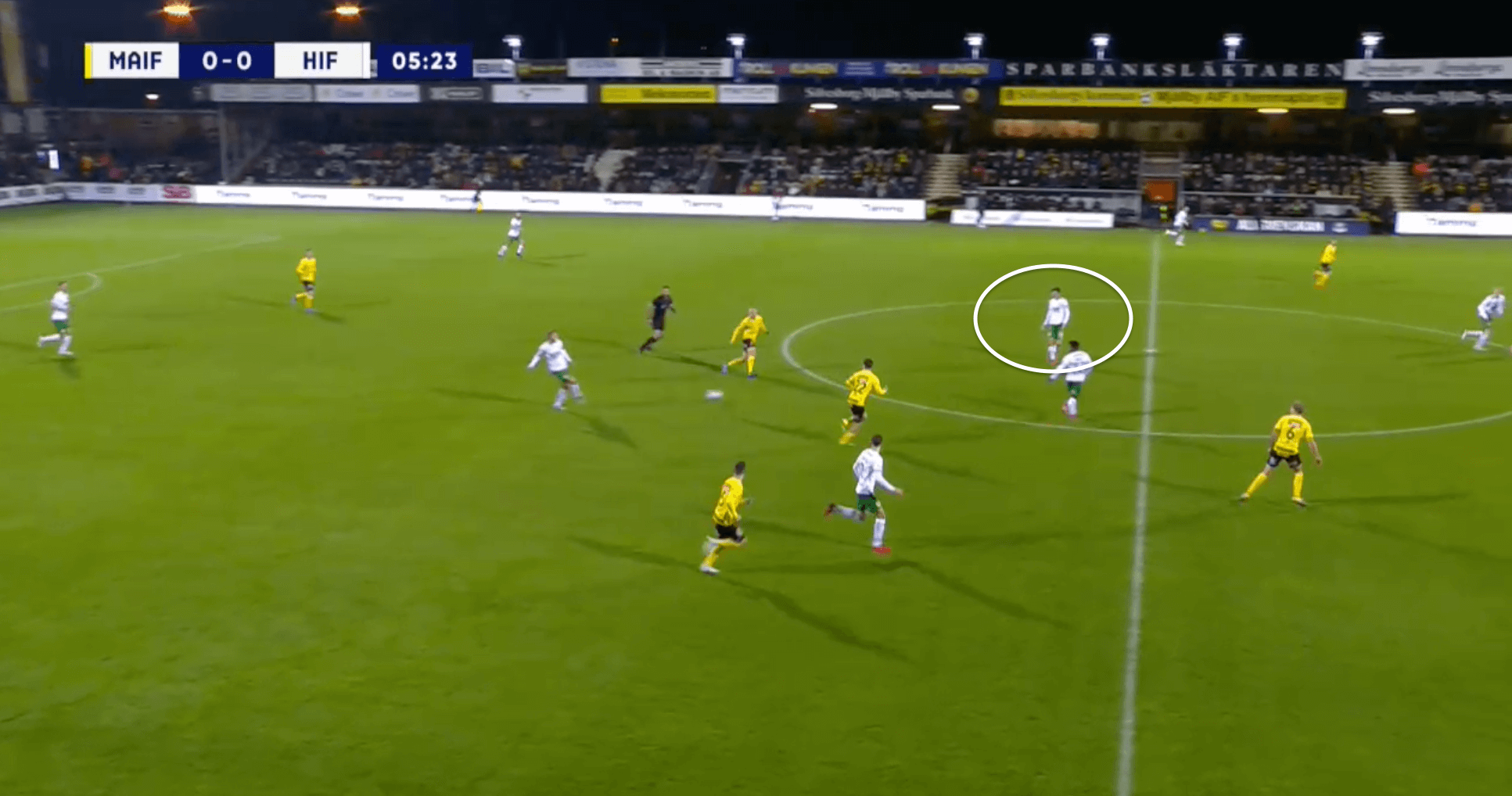
But one particular aspect of his movements that can improve is his combinational play with his wingers or full-backs out in the wing. There were many instances in the games he has played where once he passes the ball to the full-back, he stays in his position instead of making an underlapping run. He does underlap or runs into the channels with a sudden burst or he wasn’t particularly involved in the last 3-4 actions for his team, but this ability to play touch and go with his teammates can be very valuable and is something he can certainly develop to develop his off-ball game further. We can see an example of that in the image below where after passing the ball to his teammate in the wing, he stops accelerating instead of making the run forward. This means that his teammate (number 33) gets double-teamed by another midfielder recovering back.
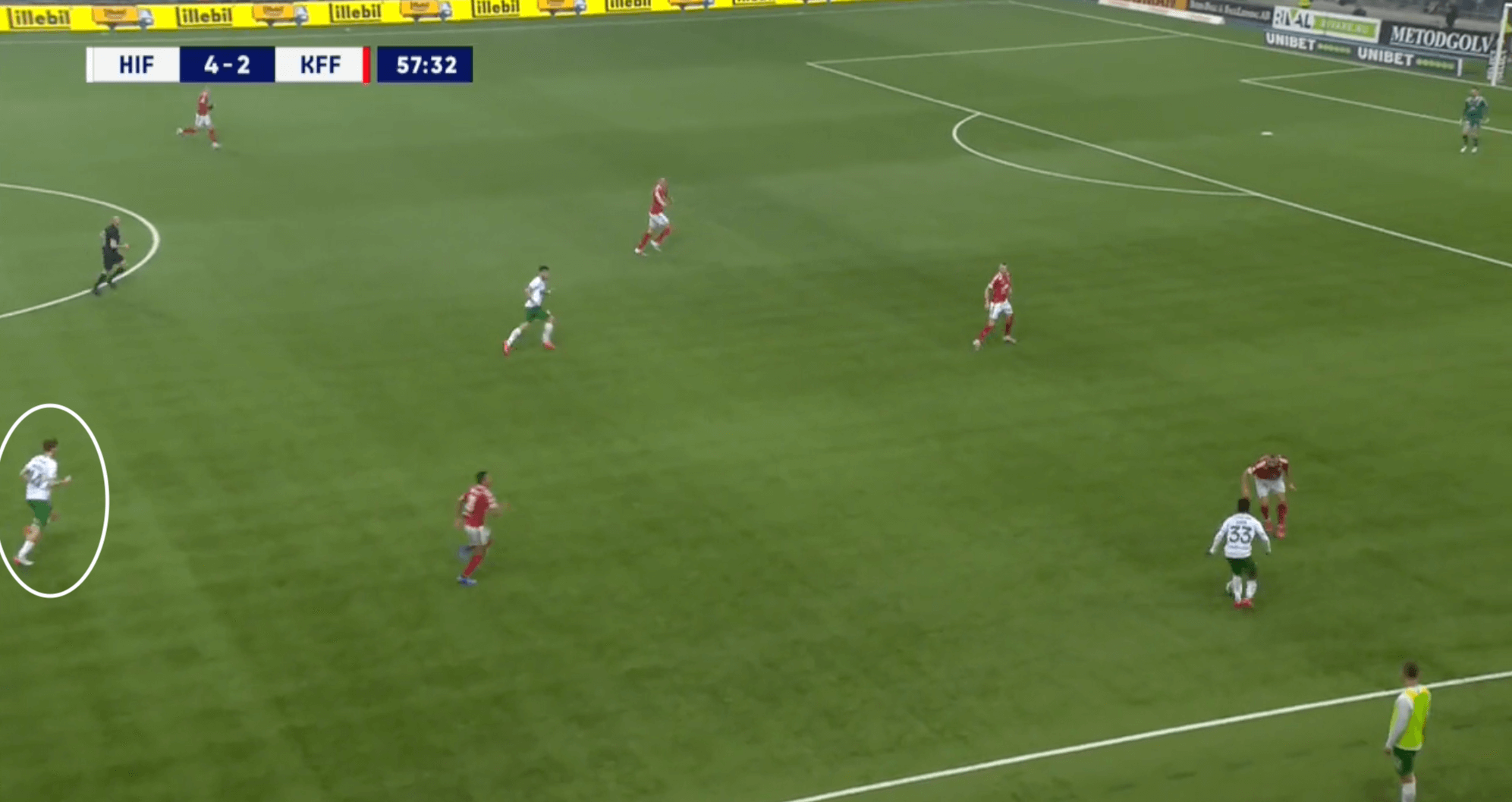
On-the ball attacking abilities
As much as off-ball movements are important, the ability on the ball is equally or sometimes over-valued. Swedberg has a good first touch with both his foot with very good weight when he receives the ball. We can see an example of his ability to receive the ball with his weaker foot when the pass played to him was misplaced. His teammate is looking to lay off the ball to him with his first touch and Swedberg has also got his body oriented in the right angle to receive the ball in front of him and carry it forward. But the pass was mishit and Swedberg had to make last-minute adjustments and receive it in his left foot. He immediately turns and plays it square to the opposite flank.
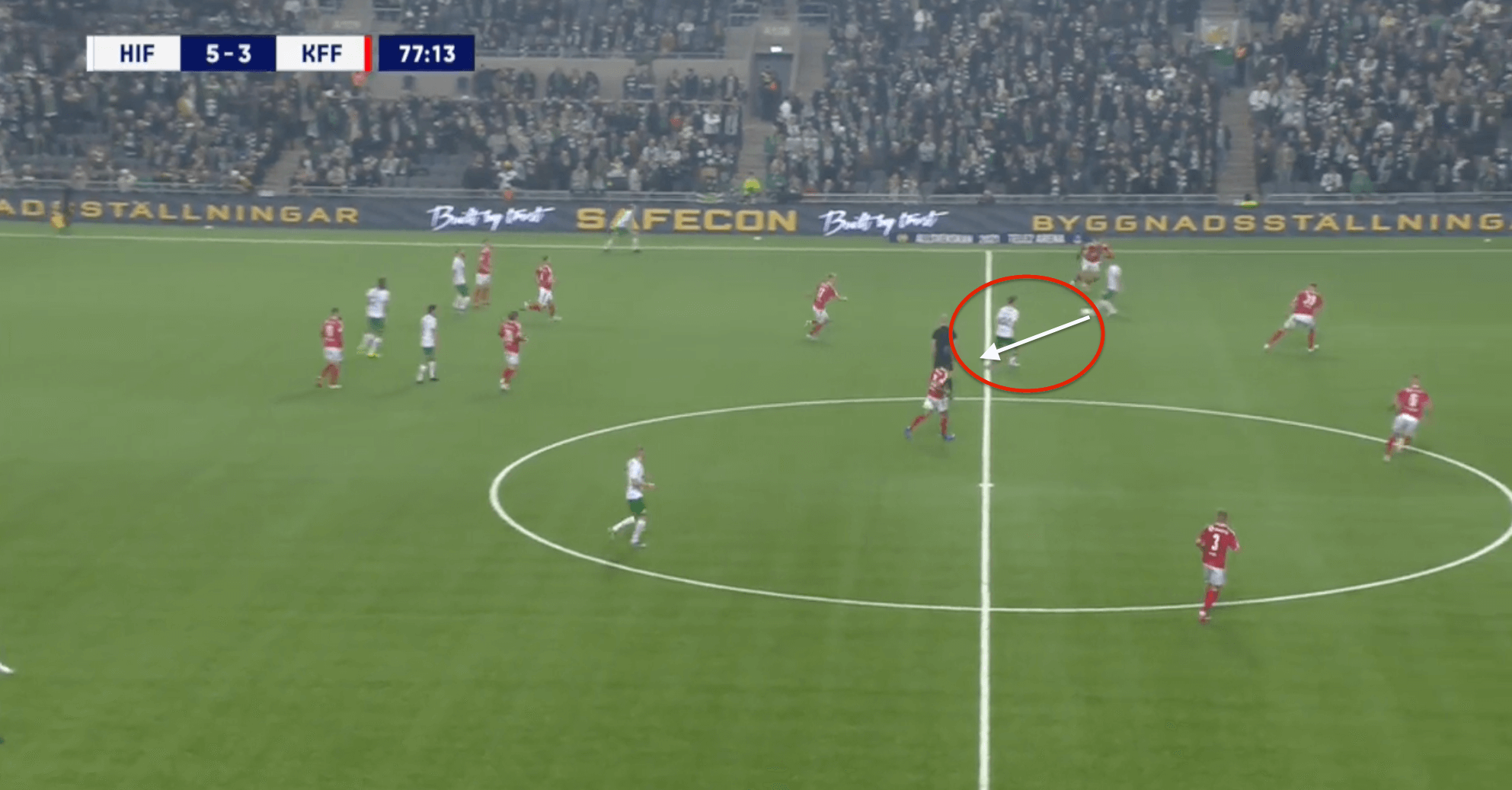
Despite being deployed as slightly an advanced CM, he is also instructed to drop deep to help his side’s buildup. We can see in the image below where he drops on the side of the backline and receive the ball while the full-back on that side is given the licence to go higher up the pitch.
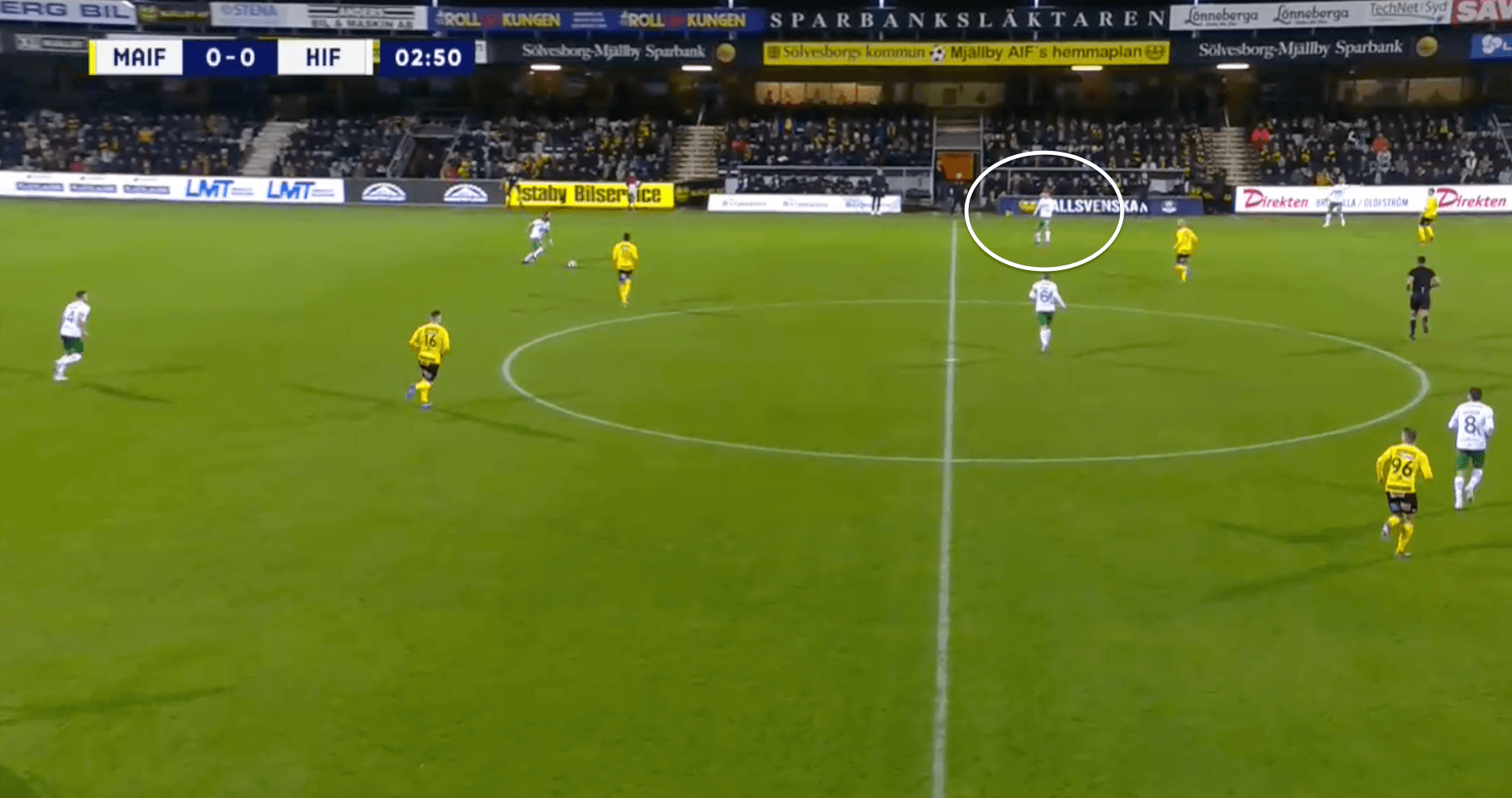
But this is one area (dropping deep) where he has a lot of fundamentals to be ironed out. In many instances, he unnecessarily drops deep which makes not only himself but also the teammates around him very much redundant and leads to improper staggering. We can see an example of that in the image below where he drops deep and that brings another opponent following him which allows their team to create a pressing trap effectively.

Even in the above example, another issue with him in such situations is his body angle when drops deep. He orients himself in a very closed angle that closes most of the forward passing options which means that he can just pass it backwards. We can see another example of him having a very closed angle when he drops deep and receives in the image below. Especially in this example, his situation is made much worse where he is already closed down by two players beside him and by the time he turns he would be dispossessed or be put under huge pressure. The risk in this situation is very high and there are high chances of him losing possession immediately.
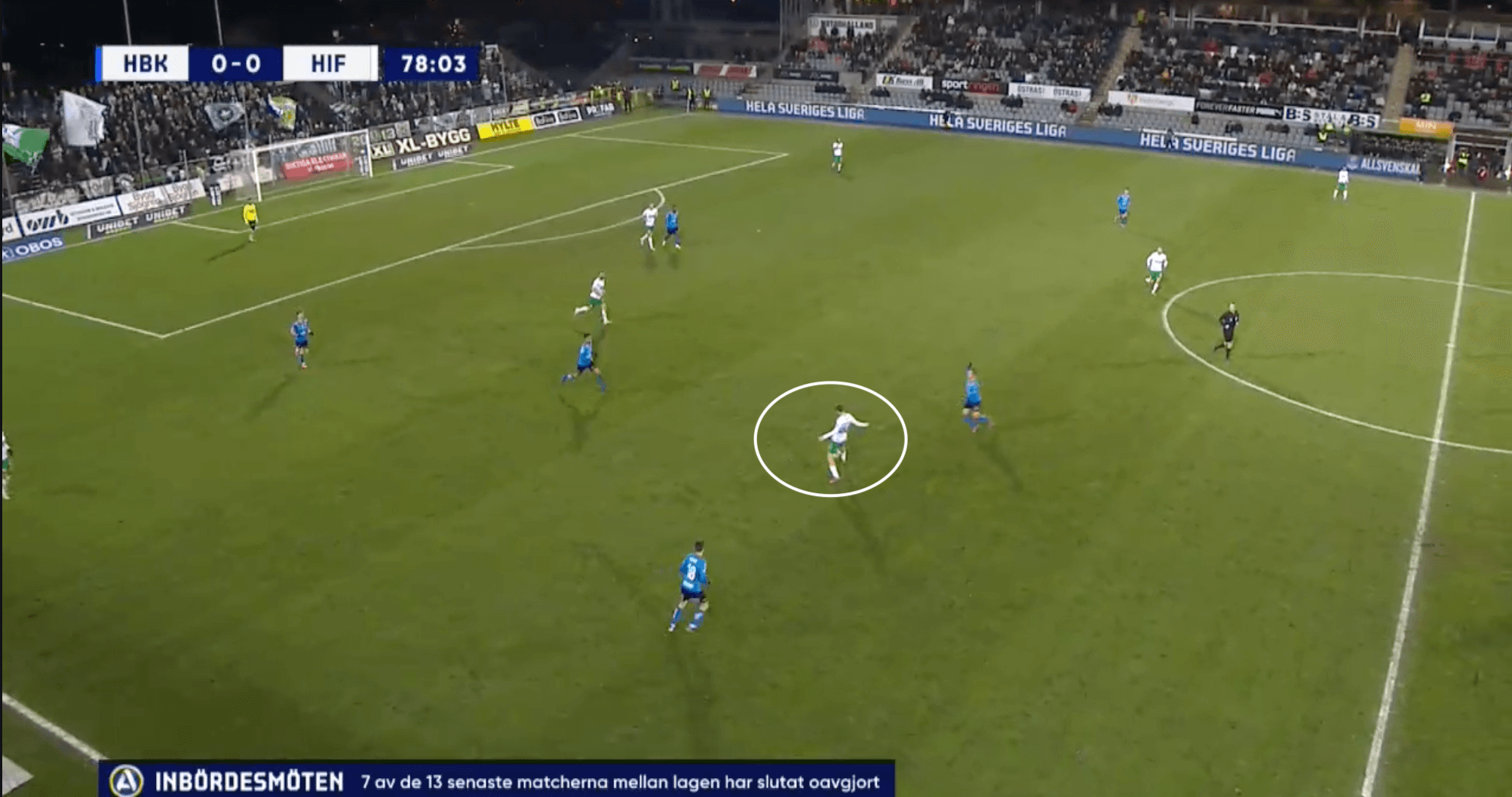
In most of these situations, he improvises by receiving well with his feet and turning swiftly and moving the ball forward by attempting a pass or carrying. We can see him doing that in the image below where takes it with his weaker foot and turns immediately. But the time lag taken to do this full turn when he has a closed shape means that it might not be very often successful. The obvious solution is to incorporate a more open shape that is sustainable against pressure by the opponents.
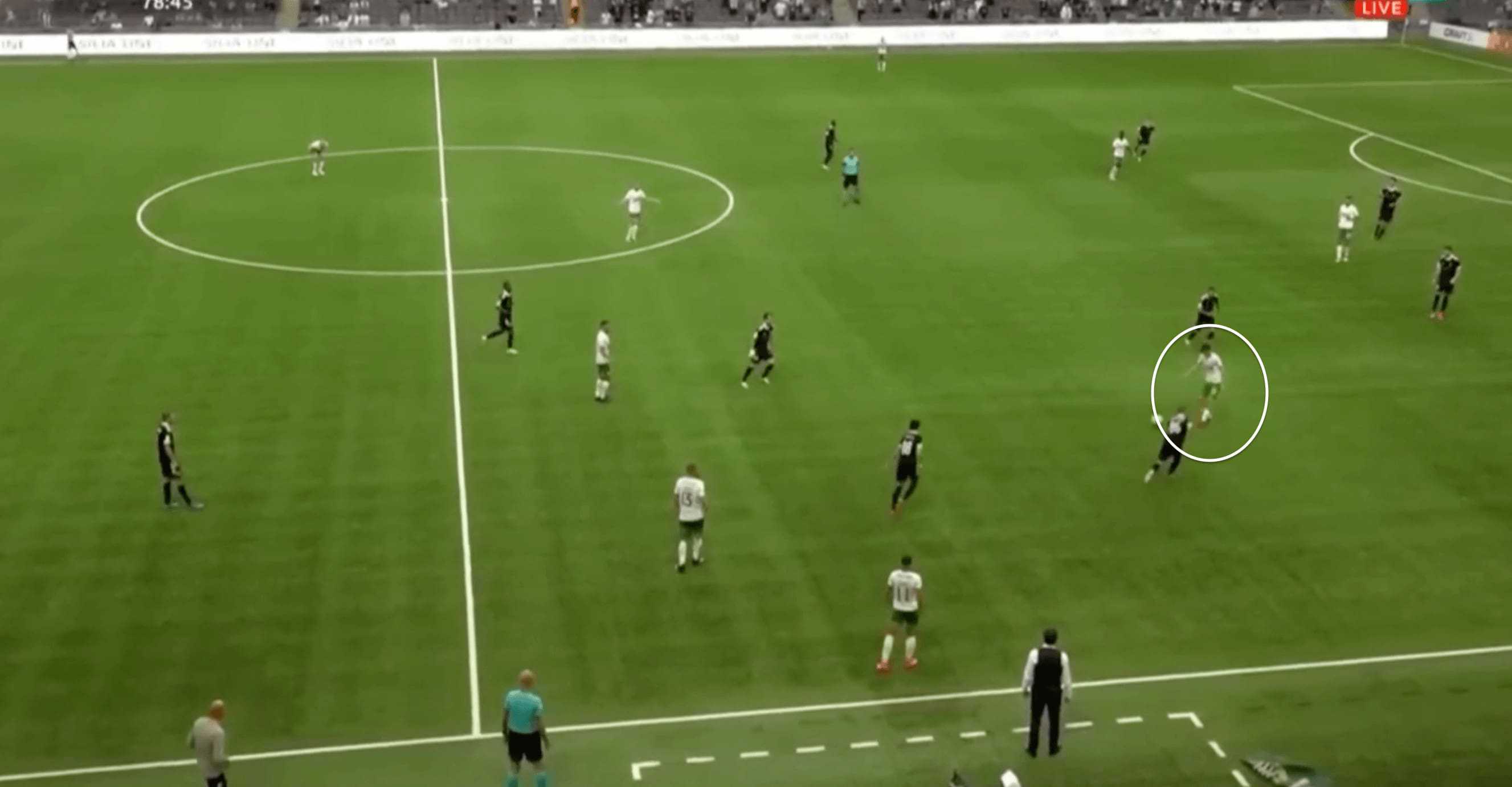
Playing as a CAM he is not exactly a very creative player as he hasn’t registered a single assist yet and his xA is only 0.78 per game. He also averages only 0.66 shot assists per game this season for both club and his national youth team. So most of his involvement in the box is him receiving the pass and not mostly playing it for his teammates.
He is not exactly a playmaker type too or at least for, now attempting progressive passes to his teammates where he averages 4.61 of such per game. He does decently well in pressured situations but he is exactly not someone that can keep beating his man 1v1 situations every time. He averages 4.61 dribbles per game with an accuracy of 54% but we have to mind the sample size here as he mostly made only substitute appearances. He likes to carry the ball through especially with space ahead of him. This has seen him make 2.2 progressive runs per game this season.
We can see that in the image below where carries the ball after finding space in front of the defence. What else we can see that is he overdoes his carrying and meets traffic of 3 opponents defending. His decision making here is something that he can or will certainly improve as he nurtures at the highest level.
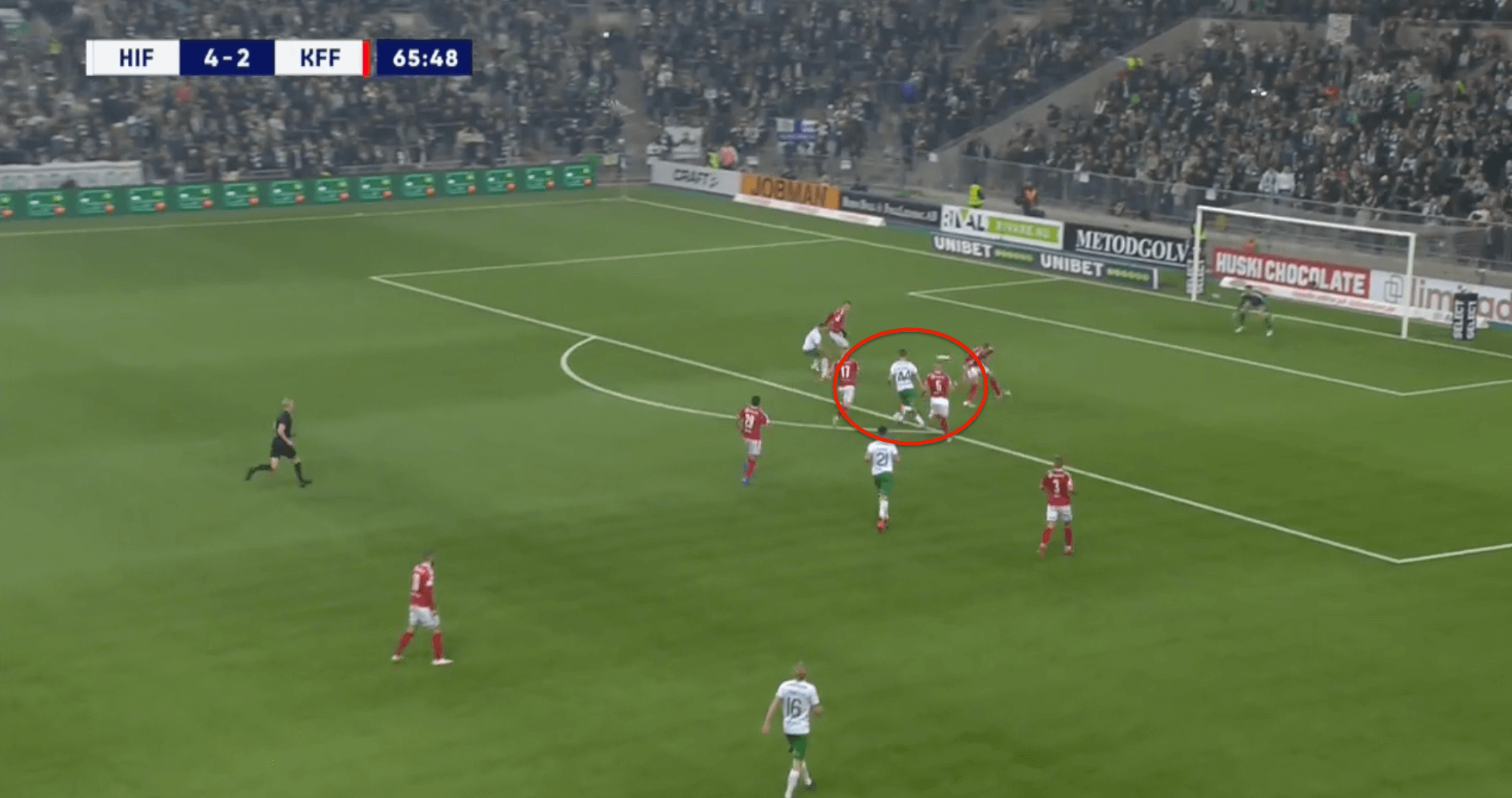
He averages 3.4 passes/carries into the penalty area per game which is a good number. Though like the above example most of that is a carry, he does have good vision to find teammates by playing through the defenders especially finding the tiny passing lane between them and using that. We can see that in the image below where he squeezes a pass in between the 2 defenders to find his teammate. This is something that he attempts to do often and something he can be super good at in the future.
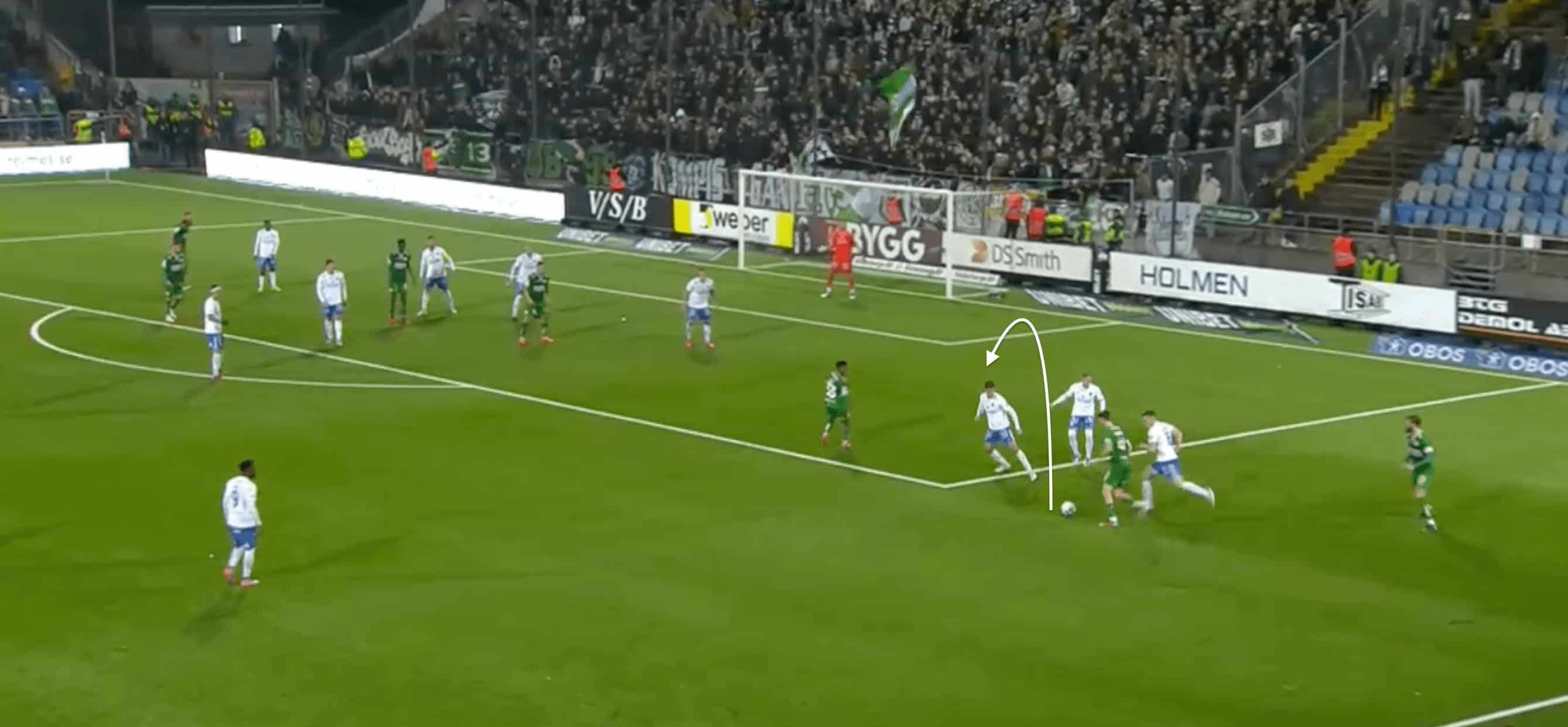
Defensive Abilities
It’s now time to see how well he fares defensively and what are his abilities when his team is out of possession. Looking from a statistically, he attempts around 10.1 defensive duels per game with a very good success rate of 58%, which can be slightly higher due to the number of minutes he has played. As said before he is generally deployed higher compared to the other midfielders in the team so most of his defensive actions when during his team’s press happen in the opposition half. He averages 1.54 recoveries in the final third and 2.63 counter-pressing recoveries.
He generally has good posture when he steps out to press and engages in a challenge. We can see that in the image below where he is pressing at a good distance from his marker. Due to his agility, he can also move swiftly if the opponent decides to do the same. His intensity in these situations are also good.
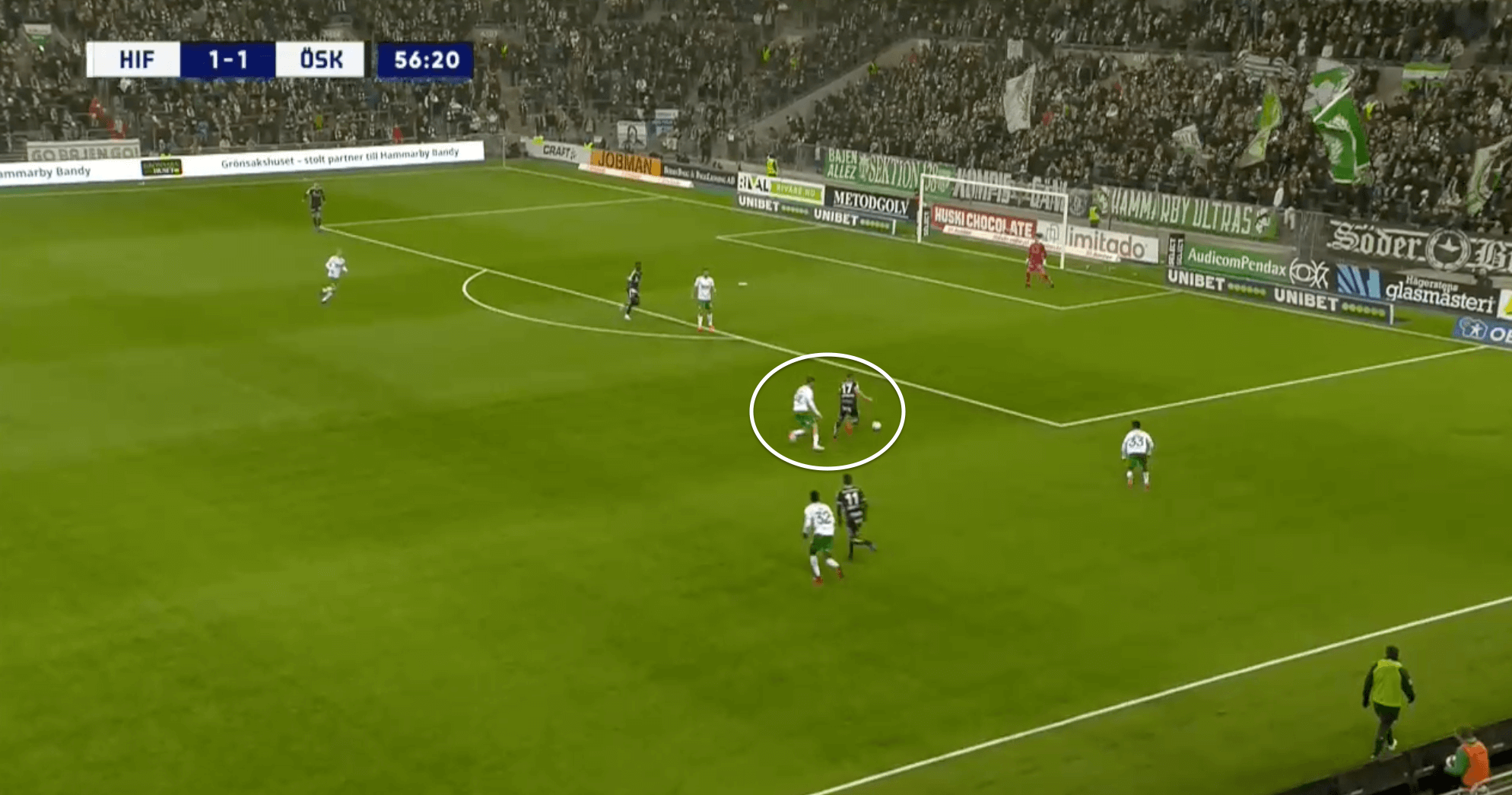
And generally, he also has good intelligence in these situations especially for a 17-year old. In the example below, his teammate pressurizes the ball carrier of the opposition. He initially cover-shadows the nearest passing option to the ball carrier. When the ball carrier has no options but to pass backwards from that angle to his goal-keeper he identifies this and times his movement forward correctly and intercepts the ball. These are some great qualities that is very difficult to see in such young players and something that comes only with experience. For Swedberg, it will only get better as he develops himself.
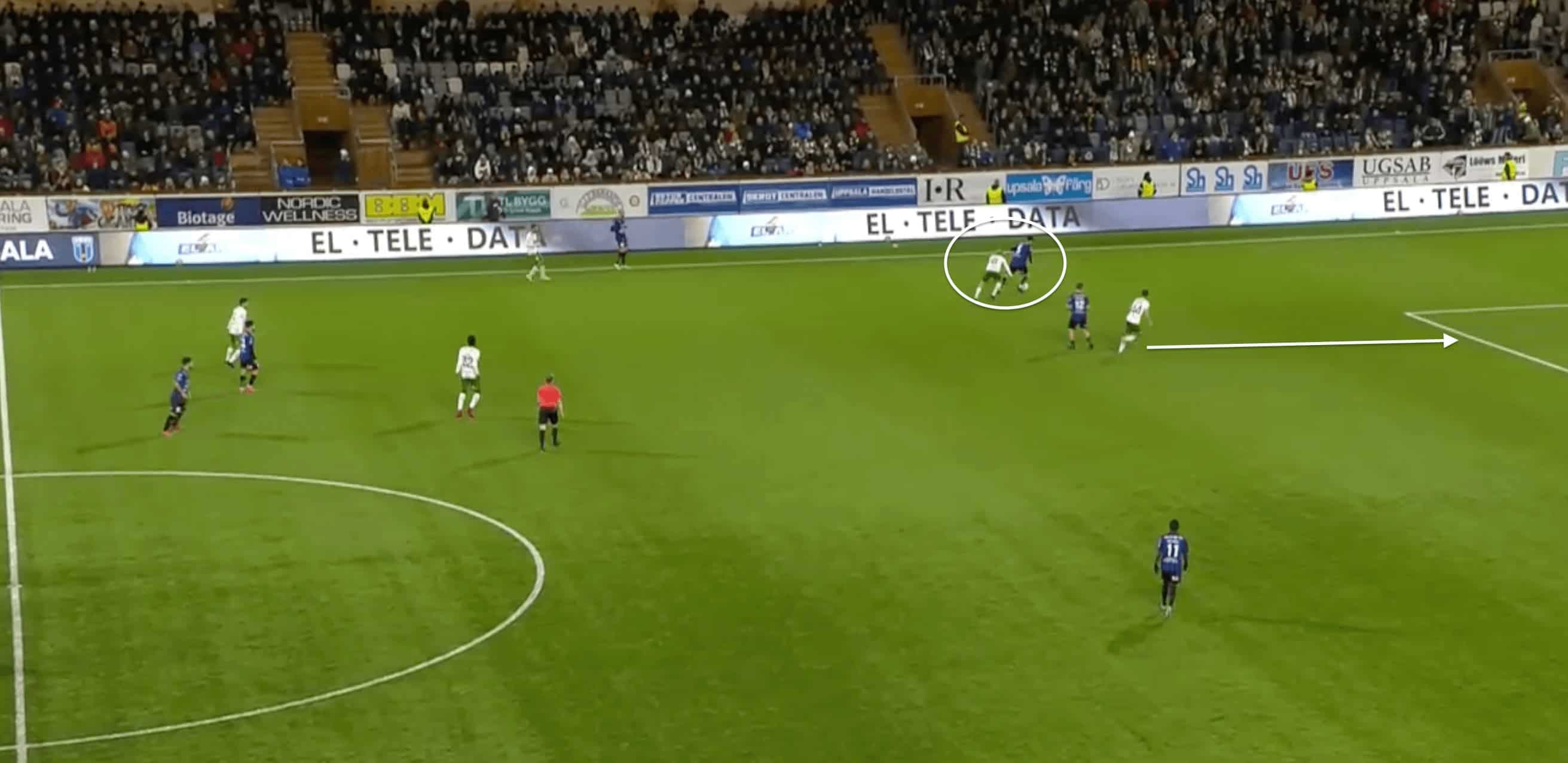
He also scans well though he can do it much more frequently especially to get a very good pitch awareness. We can see an example of him doing it to scan that there is a passing option for the ball carrier to play it forward. He immediately recognizes this and adjusts his body by looking to block the passing option that leads to the option being closed for that player. These minute things are very important attributes to have for a youngster and Swedberg seems to have picked it up or slowly picked it up at a very young age.
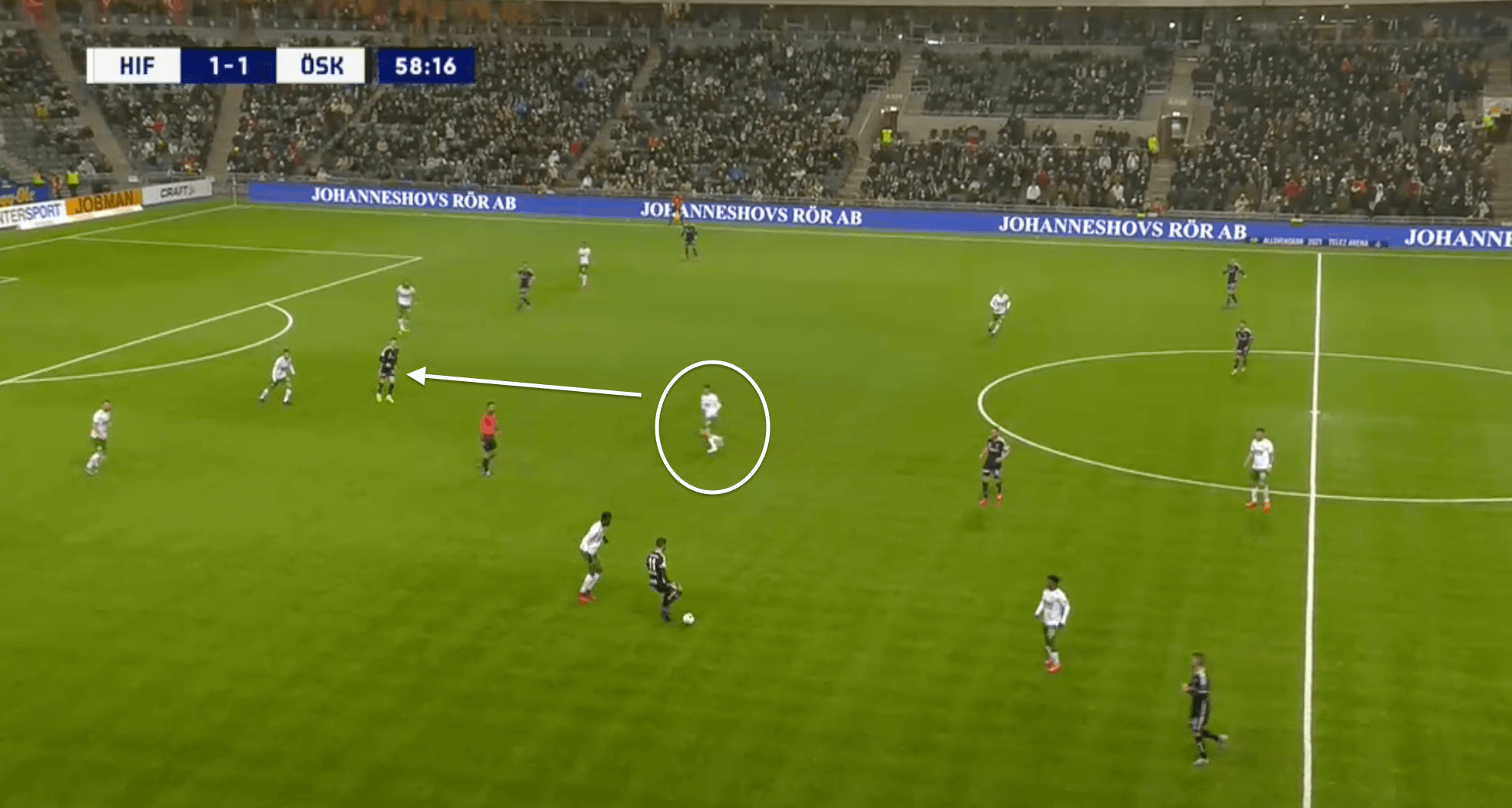
One thing that he would have to definitely have to work is his ability to track back and defend hard for his team. There were instances where he would not sprint back or follow a player when he makes a run forward. We can see an example of that in the image below where he was initially slow in getting back to the penalty area that meant that the cut-back in front of him was played to the player and he wasn’t able to stop it.
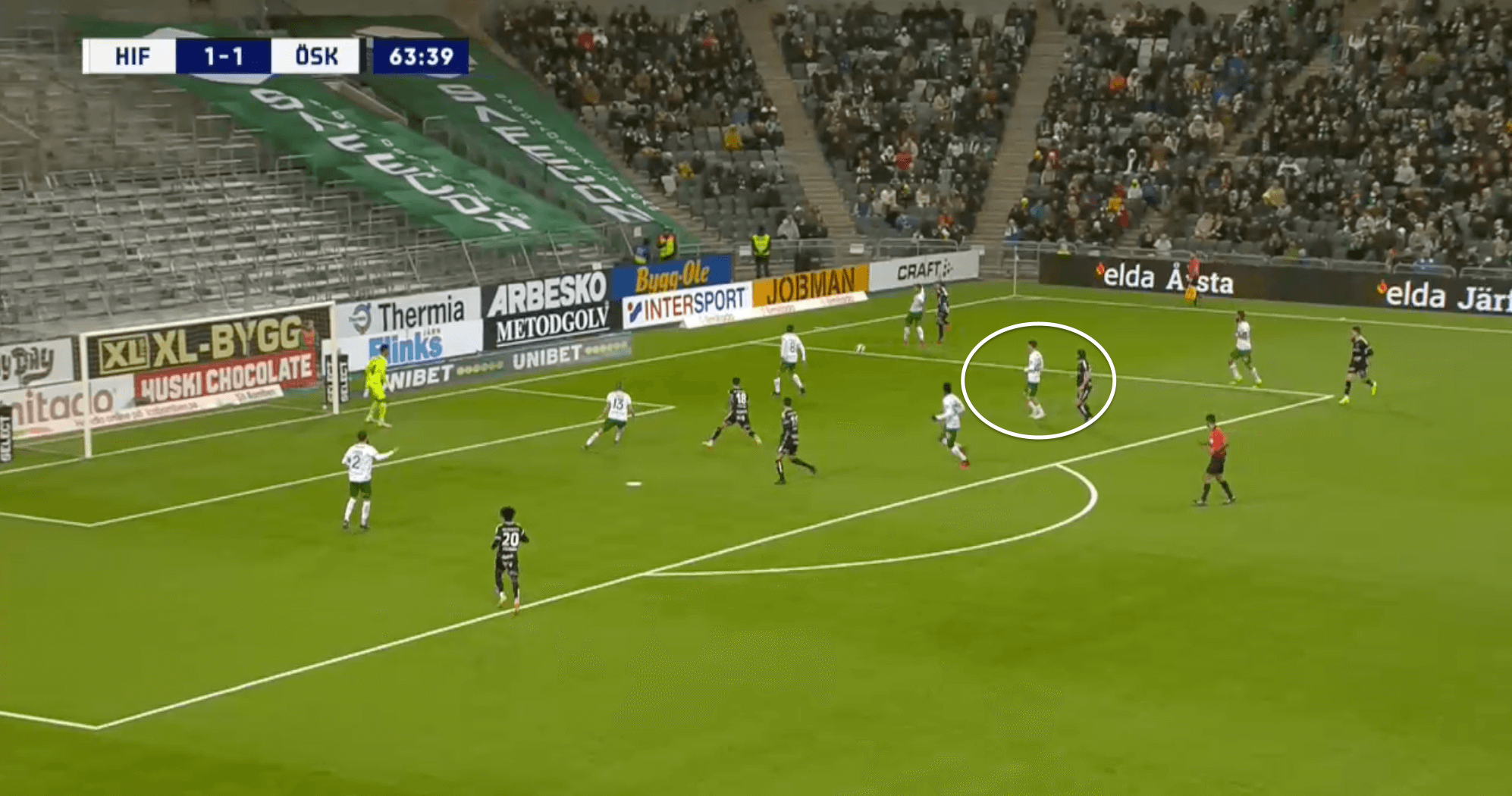
Though he is been given a free role or a much more advanced role due to his age, this is something that he would have to work on if he wants to play for top clubs in Europe where managers would demand a very coherent behaviour out of possession and willing to do the hard work for the team.
Conclusion
On the outset, Swedberg is a very exciting prospect coming with a very unique and valuable set of skills already with him. Still 17, he has still a couple of years left in his teenage period and almost a decade before he hits his peak. If he can show more development he would be one of the hottest prospects in Europe and Sweden and would definitely attract the interest of many top European clubs.

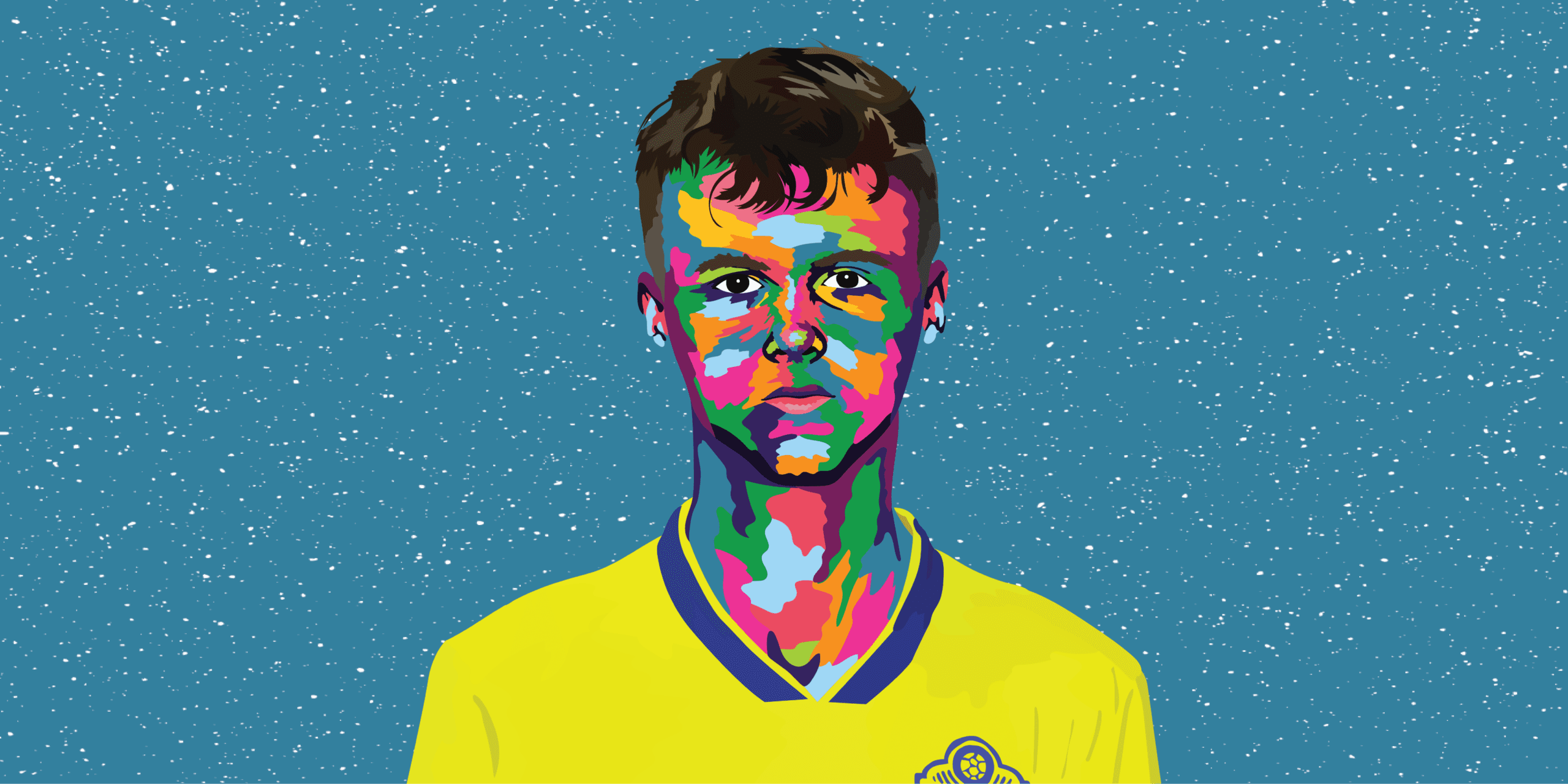




Comments